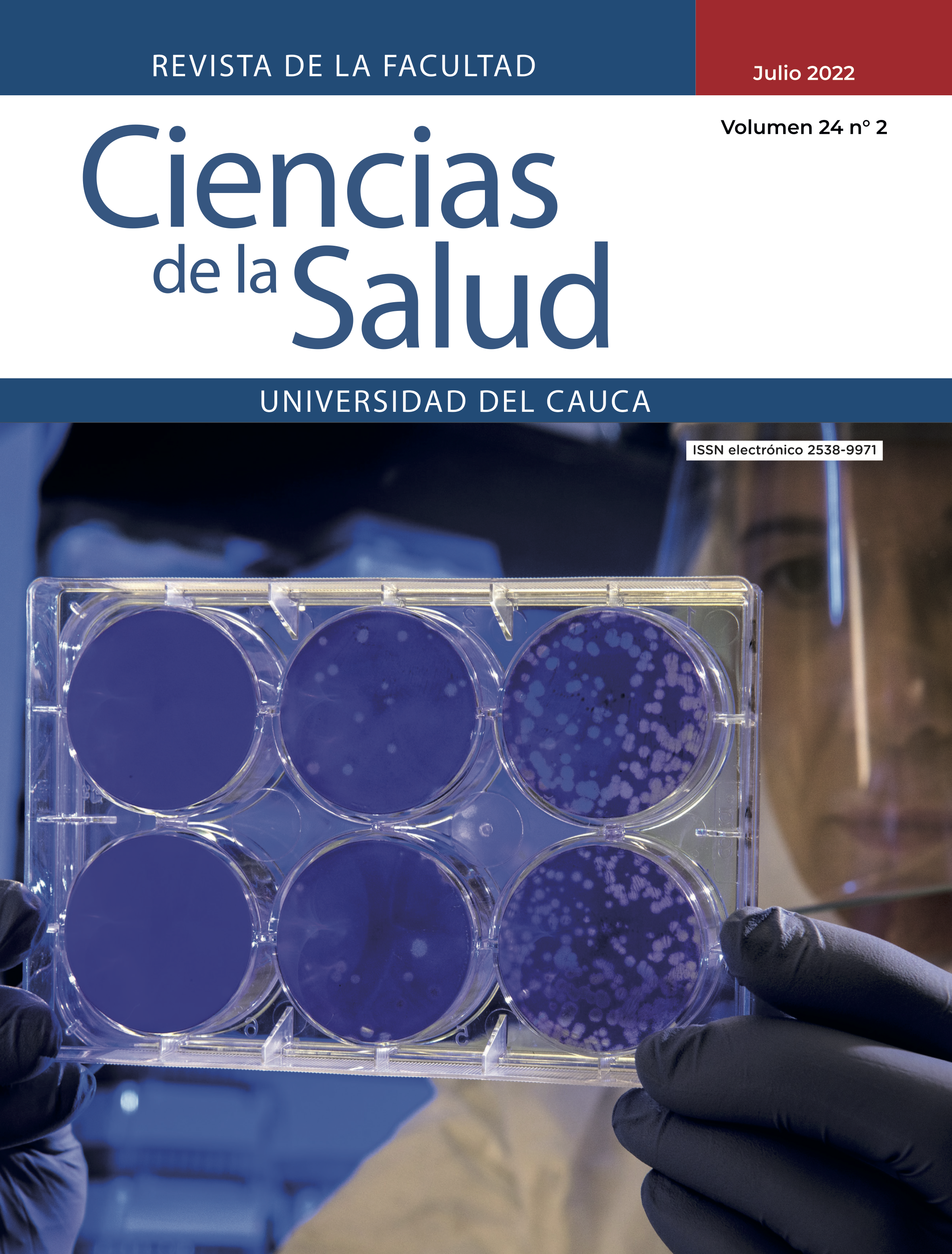N-acetylcysteine as an adjuvant in the management of cocaine and tobacco craving. Narrative review
Abstract
By 2021, it is estimated that 36.3 million people will develop substance use disorders worldwide. In Colombia, tobacco and cocaine are two of the most widely used legal and illegal substances. The craving, or desire to consume or use, is a characteristic associated with substance use disorders, which in turn is one of the reasons that explain relapses and abandonment of therapeutic processes.
A potential therapeutic strategy for its treatment is the use of N-acetylcysteine, which has been implicated in the regulation of the levels of the neurotransmitter’s cysteine and glutamate. This narrative review was aimed to outline the pharmacological mechanisms of N-acetylcysteine and review the current evidence on its usefulness in cocaine and tobacco craving. A structured search of the literature was carried out, obtaining 12 articles between the period 2015-2021, most of them with methodological limitations. Recent evidence maintains that there may be biological plausibility for the use of N-acetylcysteine as an adjuvant in the management of craving, but there is still a lack of robust information for its widespread use or to generate recommendations.
Downloads
Disciplines:
Toxicology, DependencyReferences
The United Nations Office on Drugs and Crime (UNODC). World Drug Report 2021 (United Nations publication, Sales No. E.21.XI.8). [Internet]. Vol. 2. United Nations publication, Sales No. E.20.XI.6); 2021. 113 p. Disponible en: https://www.unodc.org/unodc/en/data-and-analysis/wdr2021.html
World Health Organization. WHO global report on trends in prevalence of tobacco use 2000-2025 [Internet]. third edition. 2019. 121 p. Disponible en: https://www.who.int/publications/i/item/who-global-report-on-trends-in-prevalence-of-tobacco-
use-2000-2025-third-edition
Peña-Torres E, Osorio D, Gamboa O, Caporale J, Augustovski F, et al. Carga de enfermedad atribuible al uso de tabaco en Colombia y potenciales beneficios sanitarios y económicos del aumento del precio del cigarrillo mediante impuestos. Revista Colombiana de Cancerología. 2019; 23(4): 135-43. https://doi. org/10.35509/01239015.31
The United Nations Office on Drugs and Crime (UNODC). World Drug Report 2021. Drug Market Trends: Cocaine, amphetamine- type stimulants [Internet]. Vol. 4. United Nations publication, Sales No. E.21.XI.8; 2021. 103 p. Disponible en: https://www.unodc.org/peruandecuador/es/noticias/2021/informe-mundial-sobre-drogas-2021.html
Observatorio Europeo de las Drogas y las Toxicomanías, 2020. Oficina de publicaciones de la Unión Europea. Informe Europeo de sobre drogas, tendencias y novedades. [Internet]. Luxemburgo; 2021 p. 60. Disponible en: https://www.emcdda. europa.eu/system/files/publications/13838/2021.2256_ ES0906.pdf
The United Nations Office on Drugs and Crime (UNODC). World Drug Report 2021. Executive Summary. Policy Implications. [Internet]. Vol. 1. United Nations publication, Sales No. E.21.XI.8; 2021. 85 p. Disponible en: http://www.odc.gov.co/Portals/1/publicaciones/pdf/WDR21_Booklet_1.pdf
Departamento Administrativo Nacional de Estadística (DANE), Ministerio de Justicia y Derecho de Colombia. Encuesta nacional de consumo de sustancias psicoactivas (ENCSPA) [Internet]. 2020. Disponible en: https://www.dane.gov.co/index.php/en/estadisticas-por-tema/salud/encuesta-nacional-de-consumo-de-sustancias-psicoactivas-encspa
Gómez C. Ubier Eduardo, Berrouet MC. Tabaco: enfoque y tratamiento del paciente con dependencia. En: Adicciones, aspectos clínicos y psicosociales, tratamiento y prevención. Primera edición. 2013. p. 509-17.
GBD 2019 Diseases and Injuries Collaborators. Global burden of 369 diseases and injuries in 204 countries and territories, 1990-2019: a systematic analysis for the Global Burden of Disease Study 2019. Lancet. 2020; 396(10258): 1204-1222. https://doi.org/10.1016/S0140-6736(20)30925-9
Correa Muñoz AM, Pérez Gómez A. Relación e impacto del consumo de sustancias psicoactivas sobre la salud en Colombia. Liberabit. 2013; 19(2): 153-62.
Chan B, Kondo K, Freeman M, Ayers C, Montgomery J, Kansagara D. Pharmacotherapy for Cocaine Use Disorder-a Systematic Review and Meta-analysis. J Gen Intern Med. 2019; 34(12): 2858-2873. https://doi. org/10.1007/s11606-019-05074-8
Al- Malky, Hamdam S. Neuropharmacology of nicotine dependence. Internacional Journal of Research in Pharmaceutical Sciences [Internet]. 2020;11(1). Disponible en: https://www.pharmascope.org/index. php/ijrps/article/view/1905
American Psychiatric Association. Trastornos relacionados con sustancias y trastornos adictivos. En: Manual Diagnóstico y Estadístico de los trastornos mentales DSM-5. 5 edición. Editorial Médica Panamericana; 2014. p. 481-589.
Koob GF. Addiction is a Reward Deficit and Stress Surfeit Disorder. Front Psychiatry 2013;4. https://doi.org/10.3389/fpsyt.2013.00072
Sánchez-Hervás E, Molina Bou N, Del Olmo Gurrea R, Tomás Gradolí V, Morales Gallús E. Craving y adicción a drogas. Trastornos Adictivos 2001; 3: 237–43. https://doi.org/10.1016/s1575-0973(01)78570-4
Cavicchioli M, Vassena G, Movalli M, Maffei C. Is craving a risk factor for substance use among treatment-seeking individuals with alcohol and other drugs use disorders? A meta-analytic review. Drug Alcohol Depend. 2020; 212: 108002. https://doi.org/10.1016/j.drugalcdep.2020.108002
Uhl GR, Koob GF, Cable J. The neurobiology of addiction. Ann N Y Acad Sci. 2019 Sep;1451(1):5-28. https://doi.org/10.1111/nyas.13989
Horseman C, Meyer A. Neurobiology of Addiction. Clin Obstet Gynecol. 2019 Mar;62(1):118-127. https://doi.org/10.1097/GRF.0000000000000416
Koob GF, Volkow ND. Neurocircuitry of addiction. Neuropsychopharmacology. 2010; 35(1): 217-38. https://doi.org/10.1038/npp.2009.110. Erratum in: Neuropsychopharmacology. 2010; 35(4): 105
Kocalevent RD, Fliege H, Rose M, Walter M, Danzer G, Klapp BF. Autodestructive syndromes. Psychother Psychosom. 2005;74(4):202-11. https://doi. org/10.1159/000085143
Koob GF, Volkow ND. Neurobiology of addiction: a neurocircuitry analysis. Lancet Psychiatry. 2016; 3(8): 760-773. https://doi.org/10.1016/S2215-0366(16)00104-8
Volkow ND, Boyle M. Neuroscience of Addiction: Relevance to Prevention and Treatment. Am J Psychiatry. 2018;175(8):729-740. https://doi.org/10.1176/appi. ajp.2018.17101174
Camenga DR, Klein JD. Tobacco Use Disorders. Child Adolesc Psychiatr Clin N Am. 2016; 25(3): 445-60.
Wang X. Brain Structural Consequences of Chronic Cocaine Exposure and Their Effects on Behavior. Biol Psychiatry. 2021; 89(4): e11-e12.
Drake LR, Scott PJH. DARK Classics in Chemical Neuroscience: Cocaine. ACS Chem Neurosci. 2018; 9(10): 2358-2372. https://doi.org/10.1021/acschemneuro.8b00117
Howland M A, Hendricson R G. N-acetylcysteine. En: Goldfrank´s Toxicological Emergencies. 11th Edition. Mc Graw Hill Education; 2019. p. 492-500.
Frye Richard Eugene. Clinical Trials on N-Acetylcysteine. En: The Therapeutic Use of N-Acetylcysteine (NAC). Adis; 2019. p. 139-46.
Elbini Dhouib I, Jallouli M, Annabi A, Gharbi N, Elfazaa S, Lasram MM. A minireview on N-acetylcysteine: An old drug with new approaches. Life Sci. 2016;151:359-363. https://doi.org/10.1016/j.lfs.2016.03.003
Womersley Jacqueline S, Townsend Danyelle M, Kalivas Peter W., Uys Joachim D. Targeting Redox Regulation to Treat Substance Use Disorder using N-acetylcysteine. European Journal of Neuroscience. 2019; 50(3): 2538-51. https://doi.org/10.1111/ejn.14130
Berríos-Cárcamo P, Quezada M, Quintanilla ME, Morales P, Ezquer M, Herrera-Marschitz M, Israel Y, Ezquer F. Oxidative Stress and Neuroinflammation as a Pivot in Drug Abuse. A Focus on the Therapeutic Potential of Antioxidant and Anti-Inflammatory Agents and Biomolecules. Antioxidants (Basel). 2020; 9(9): 830. https://doi.org/10.3390/antiox9090830
Kalivas PW, LaLumiere RT, Knackstead L, Shen H. Glutamate transmission in addiction. Neuropharmacology. 2009; 56(1): 169-73. https://doi. org/10.1016/j.neuropharm.2008.07.011
Foster Olive M, Powell G, McClure E, Gipson C. Neurotransmitter Systems: Glutamate. En: The Therapeutic Use of N-Acetylcysteine (NAC) in Medicine. Adis; 2019. p. 19-28.
Gipson CD, Rawls Scott, Scofield MD, Siemsem BM, Bondy EO et al. Interactions of neuroimmune signaling and glutamate plasticity in addiction. Journal of Neuroinflammation. 2021; 18(56). https://doi. org/10.1186/s12974-021-02072-8
Engeli EJE, Zoelch N, Hock A, Nordt C, Hulka LM, Kirschner M, Scheidegger M, Esposito F, Baumgartner MR, Henning A, Seifritz E, Quednow BB, Herdener M. Impaired glutamate homeostasis in the nucleus accumbens in human cocaine addiction. Mol Psychiatry. 2021 Sep;26(9):5277-5285. https://doi.org/10.1038/s41380-020-0828-z
Spencer Sade, Kalivas Peter W. Glutamate Transport: A New Bench to Bedside Mechanism for Treating Drug Abuse. International Journal of Neuropsychopharmacology. 2017; 20(10): 797-812. https://doi.org/10.1093/ijnp/pyx050
Powell G, Mc Clure E A, Foster Olive, M, Gipson C D. Clinical Treatment of Addictive Disorders with N-Acetylcysteine. En: The Therapeutic Use of N-Acetylcysteine (NAC). Adis; 2019. p. 219-33.
Gray KM, Carpenter M, Baker NL, DeSantis SM, Kryway S et al. A Double-Blind Randomized Controlled Trial of N-Acetylcysteine in Cannabis-Dependent Adolescents. The American Journal of Psychiatry. 2012;169(8):805-12.
Gray KM, Sonne SC, McClure EA, Ghitza UE, Matthews AG et al. A randomized placebo-controlled trial of N-acetylcysteine for cannabis use disorder in adults. Drug and Alcohol Dependence. 2017; 177: 249-57.
Mcketin R, Dean OM. Turner A, Kelly PJ, Quen B et al. N-acetylcysteine (NAC) for methamphetamine dependence: A randomised controlled trial. EClinicalMedicine. 2021; 38:1-10.
Deepmala S, Slattery J, Kumar N, Delhey N, Berk M et al J. Clinical Trials of N-acetylcysteine in psychiatry and neurology: A systematic review. Neuroscience and Biobehavioral Reviews. 2015; 55:294-321. https://doi. org/10.1016/j.neubiorev.2015.04.015
Dualibi MS, Cordeiro Q, Brietzke E, Ribeiro M, LaRowe S, et al. N-acetylcysteine in the treatment of craving in substance use disorders: Systematic review and meta-analysis. The American Journal of Addictions. 2017; 26(7): 660-6. https://doi.org/10.1111/ajad.12620
Nocito Echevarria MA, Andrade Reis T, Ruffo Capatti G, Siciliano Soares V, da Silveira DX, Fidalgo TM. N-acetylcysteine for treating cocaine addiction - A systematic review. Psychiatry Res. 2017; 251:197-203.
Shulte MHJ, Kaag AM, Boendermaker WJ, Band den Brink W, Van den Brink W, Goudriaan AE et al. The effect of N-acetylcysteine and working memory training on neural mechanisms of working memory and cue reactivity in regular cocaine users. Psychiatry Research: Neuroimaging 2019;287(56-59). https://doi. org/10.1016/j.pscychresns.2019.03.011
Woodcock EA, Lundlahl LH, Khatib D, Stanley JA, Greenwald. N-acetylcysteine reduces cocaine-seeking behavior and anterior cingulate glutamate/glutamine levels among cocaine-Dependent individuals. Addiction Biology. 2020; 26(2): 1-12. https://doi.org/10.1111/adb.12900
Prado Eduardo, Maes Michael, Piccoli Luiz G, Baracat Marcela, Sabattini Barbosa D. N-acetylcysteine for therapy-resistant tobacco use disorder: a pilot study. Redox Report. 2015; 20(5): 220-2. https://doi. org/10.1179/1351000215y.0000000004
Froeliger B, McConnell P.A. Stankeviciute N., McClure E.A, Kalivas P.W. The effects of N-Acetylcysteine on frontostriatal resting-state functional connectivity, withdrawal symptoms and smoking abstinence: A double-blind, placebo-controlled fMRI pilot study. Drug and Alcohol Dependence. 2015; 156: 234-42. https://doi.org/10.1016/j.drugalcdep.2015.09.021
Machado RCBR, Vargas HO, Baracat MM, Urbano MR, Verri WA Jr, Porcu M, Nunes SOV. N-acetylcysteine as an adjunctive treatment for smoking cessation: a randomized clinical trial. Braz J Psychiatry. 2020; 42(5): 519-526. https://doi. org/10.1590/1516-4446-2019-0753
Shulte MHJ, Goudriaan AE, Kaag AM, Kooi DP, van den Brink W, et al. The effect of N-acetylcysteine on brain glutamate and gamma-aminobutyric acid concentrations and on smoking cessation: A randomized, double-blind, placebo-controlled trial. Journal of Psychopharmacology. 2017; 31(10): 1377-9. https://doi.org/10.1177/0269881117730660
Schmaal L, Berk L, Hulstijn KP, Cousijn J, Wiers RW, Van den Brink W. Efficacy of N-Acetylcysteine in the Treatment of Nicotine Dependence: A Double-Blind Placebo-Controlled Pilot Study. European Addiction Research. 2011; 17(4): 211-6. https://doi.org/10.1159/000327682
Smaga Irene, Frankowska Małgorzata, Filip Małgorzata. N-acetylcysteine in substance use disorder: a lesson from preclinical and clinical research. Pharmacological Reports. 2021; 73(5): 1205-19. https://doi.org/10.1007/s43440-021-00283-7
McClure Erin A., Wahlquist Amy, Tomko Rachel L, Baker Nathaniel L; Carpenter Matthew J. et al. Evaluating N-acetylcysteine for early and end-of-treatment abstinence in adult cigarette smokers. Drug and Alcohol Dependence. 2021; 225: 1-8. https://doi.org/10.1016/j. drugalcdep.2021.108815
Copyright (c) 2022 Universidad del Cauca

This work is licensed under a Creative Commons Attribution-NonCommercial-NoDerivatives 4.0 International License.












.png)



